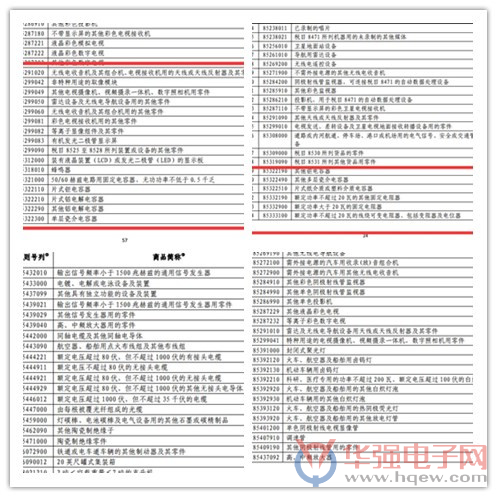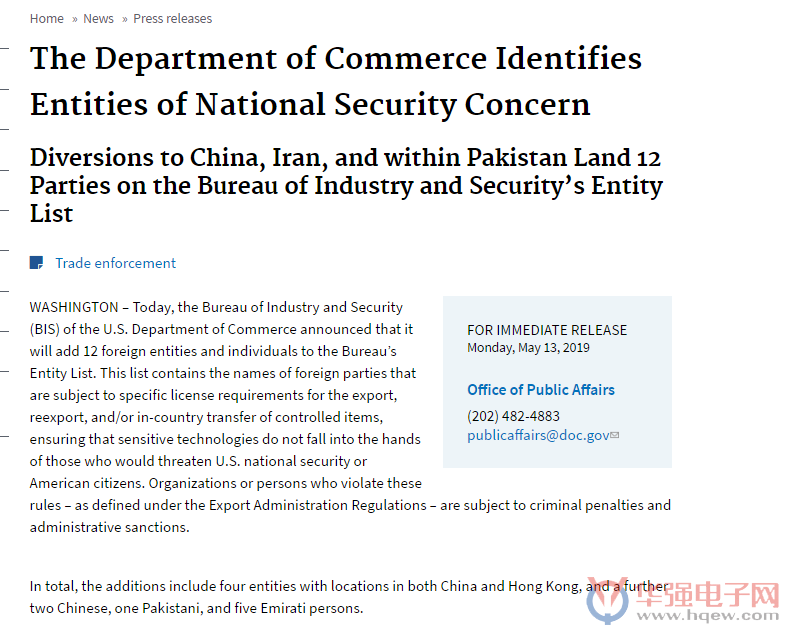

The United States, which is not accustomed to China's high-profile promotion of "made in China 2025" and all-round development of domestic semiconductor industry, can't really sit still now. After the failure of efforts to "strangle" Huawei some time ago, the angry and demoralized United States began to start from other aspects today to find a new way for its "naive" behavior.
On May 9, the U.S. government announced that since May 10, 2019, the tariff rate on the $200 billion list goods imported from China has been increased from 10% to 25%, which has come into effect. According to Nikkei news, the fourth round of tax discussion is about all the remaining imports from China, worth $325 billion. By product category, the largest is mobile phones ($43.2 billion), followed by laptops ($37.5 billion).
In response to the vexatious behavior of the United States, the Tariff Commission of the State Council of China also announced yesterday that since 0:00 on June 1, 2019, it has increased the tariff rate on the part of the 60 billion US dollar list of goods that have already been subject to additional tariff, imposing 25%, 20% or 10% of the tariff respectively, and 25% of the tariff list includes the unexposed light for semiconductor device packaging materials and PCB manufacturing. Many kinds of semiconductor materials such as anti-corrosion dry film and some semiconductor components.
25% of "you come and I go": what is the impact on the semiconductor market?
According to the reporter, on May 13, in the U.S. stock market, the Dow Jones 30 kinds of industrial shares average index all fell sharply, down 617.38 points (down 2.37%) compared with last weekend, and closed at 25324.99. The selling price dominated the whole day, the second largest drop this year. Among them, Apple's decline was the most obvious, down 6% from last weekend. In addition, trump announced the specific content of the "fourth round" sanctions tariff on all Chinese goods exported to the United States on the 13th. The tariff list just includes Apple's smart phone "iPhone" made in China.
As we all know, Apple's iPhone is related to the business of many Chinese semiconductor enterprises, such as BOE, ofI light, Changdian technology, Sinwei communication and Bourne optics, which are well-known suppliers in the industry. According to Morgan Stanley analysts, the 25% increase in tariffs on iPhones in the U.S. will hurt apple and its wide supply chain related enterprises. The increase in the cost of imported parts will also increase the cost of the iPhone XS by about $160. If these suppliers do not want to give up Apple's biggest order, the only way may be to move production bases to countries like India and Vietnam like Hon Hai to avoid the impact of the trade war.
Of course, the 25% tariff of "you come and I go" has more influence on the semiconductor market. The import tariff of many electronic components will be further increased, including capacitors, resistors, connectors for optical fiber / optical cable, signal generators and thyristor switching elements.

As can be seen from the above figure, i.e. the announcement annex issued by the tariff Committee of the State Council, the electronic components and semiconductor related products imported from the United States are listed in all four annexes. (the tariff increases in a clockwise cycle are 25%, 20%, 10% and 5% respectively, which remain unchanged. See the official website of the Tariff Commission of the State Council for details. )
The United States not only imposes export controls on these Chinese Enterprises
The U.S. attack, of course, is not simply to raise tariffs. In order to achieve its goal of fundamentally killing the rise of China's semiconductor industry, the U.S. still uses the same formula in Huawei, ZTE and Jinhua to control the export of some Chinese semiconductor enterprises.
Yesterday, the U.S. Department of Commerce issued a press release saying that four companies with physical offices in mainland China and Hong Kong are purchasing goods originating in the United States that may be used to support Iran's weapons of mass destruction and military plans, in violation of U.S. export controls. The four companies are avin electronic technology, tenco technology, yutron technology and multi Mart electronic technology, which are headquartered in Shenzhen and Guangdong respectively.

According to the editor, the business direction of these companies is slightly different. For example, avin electronic technology mainly provides the full range of electronic technology solutions, including system design and sample testing, software technology development, manufacturing and simulation, and other links are involved; while skytech and multi Mart electronic technology are mainly electronic components distribution companies, product design resistor, capacitor, inductor, led and connector, etc. But up to now, the United States has not produced any evidence to prove the accusation, just sent out a piece of paper to unilaterally impose export controls.
Summary
The ultimate goal of the U.S. is to fundamentally curb the rise of China's science and technology, especially the semiconductor industry. This round of unilateral re selection is not only an opportunity but also a challenge for China's semiconductor industry. On the surface, the market situation of China and the United States will not return to the previous boom in the short term, but it will also enable more local semiconductor manufacturers to see the "uncertainty" of the U.S. market, and make more decisions in the future when formulating market strategies for the U.S After all, it's not good to put eggs in one basket. On the other hand, with the help of this wave of momentum, more local enterprises can see that the independence of domestic semiconductors must take this step, otherwise, the future can only be played by the proud United States between applause.